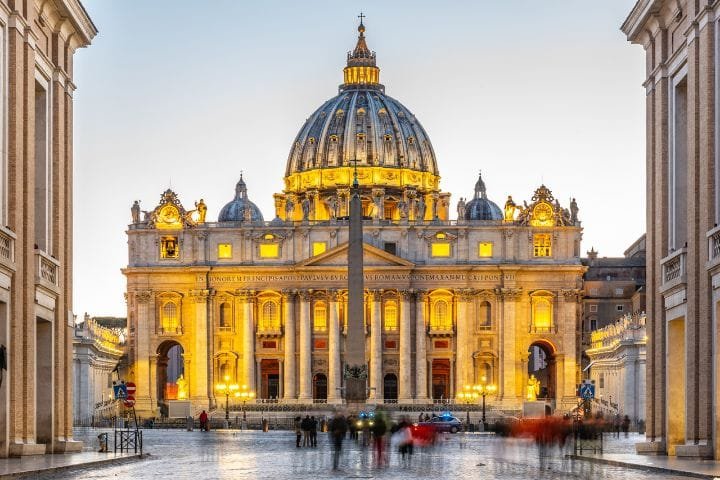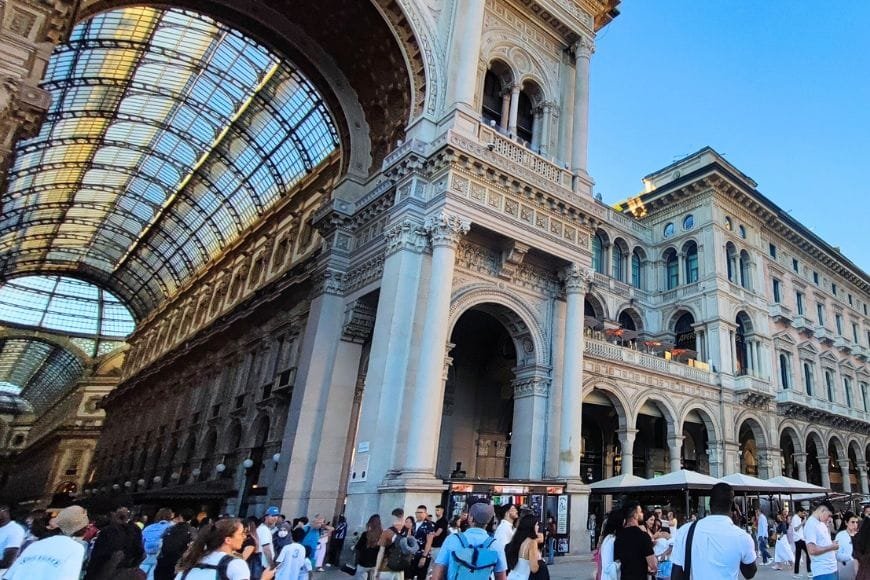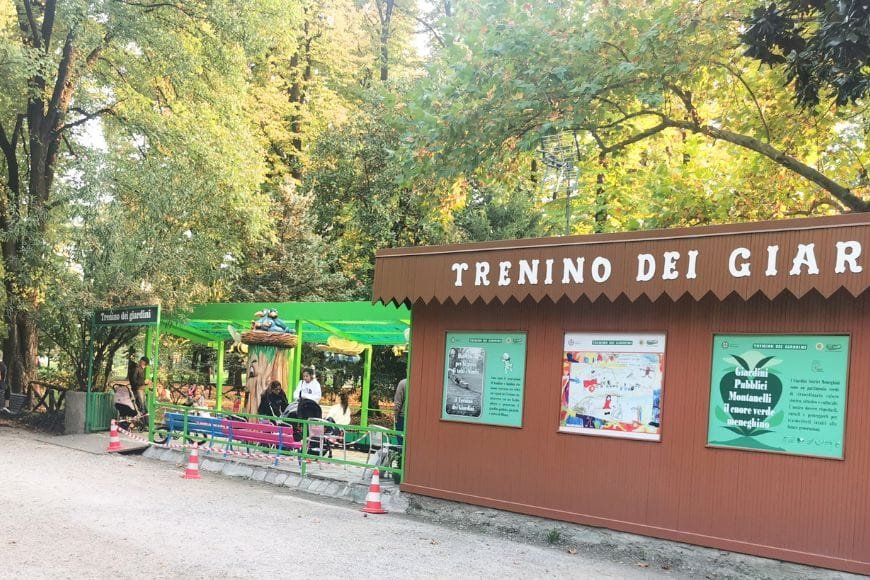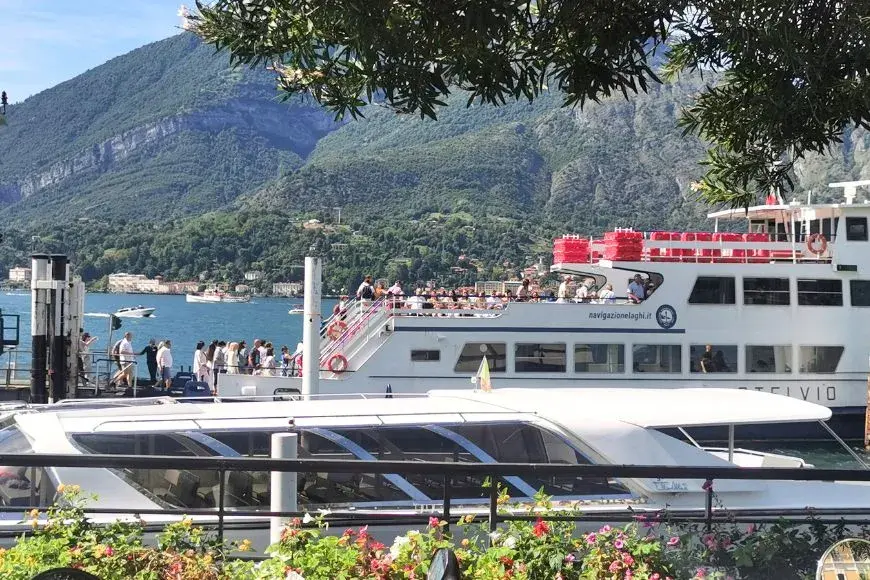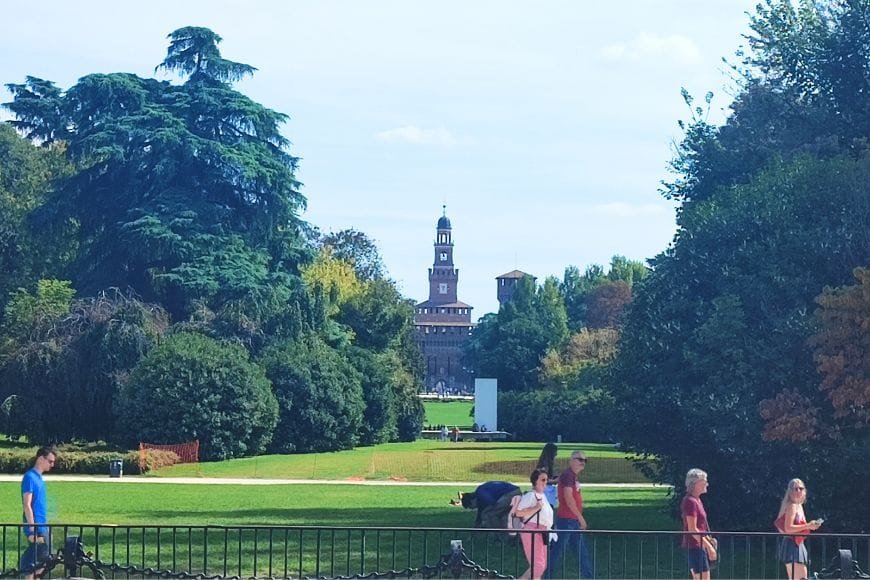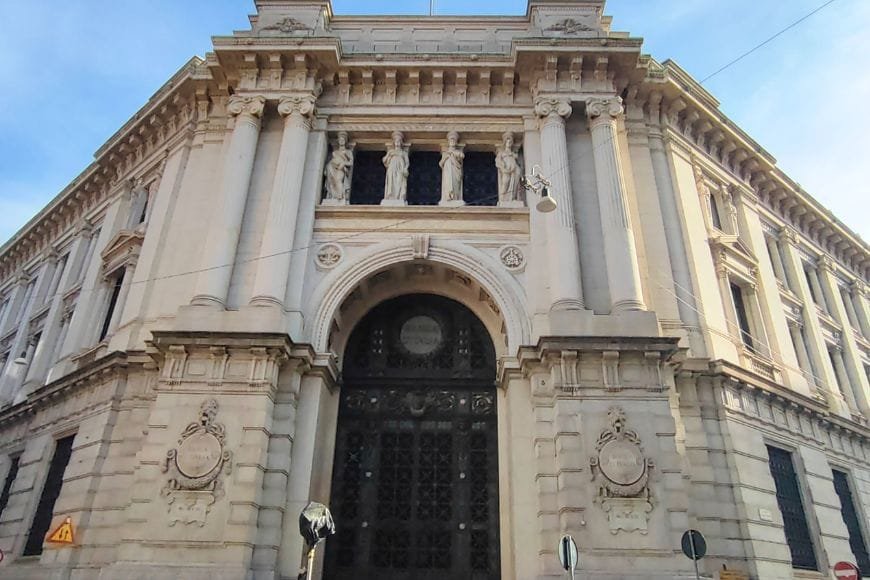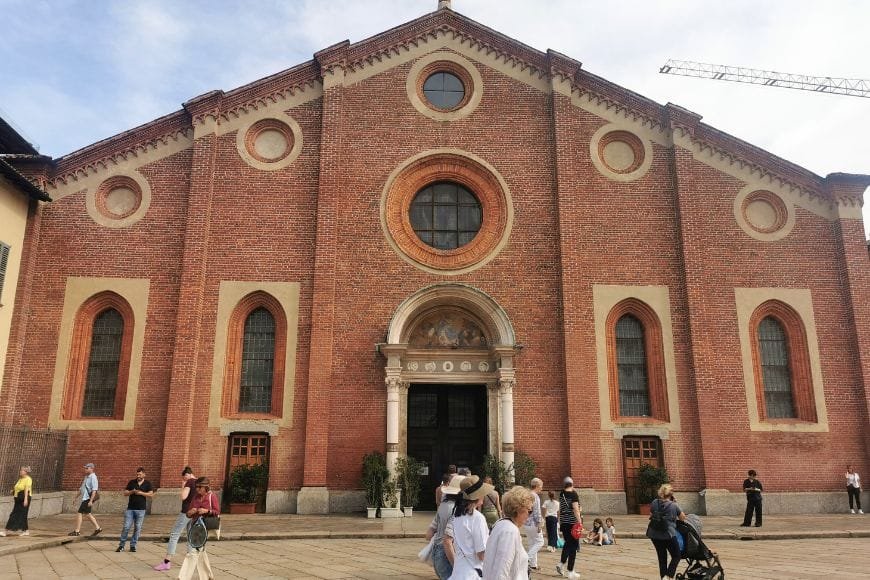Where to Stay in Milan: Best Neighborhoods & Hotels Guide (2025)

by Luca | Last Updated November 4, 2025
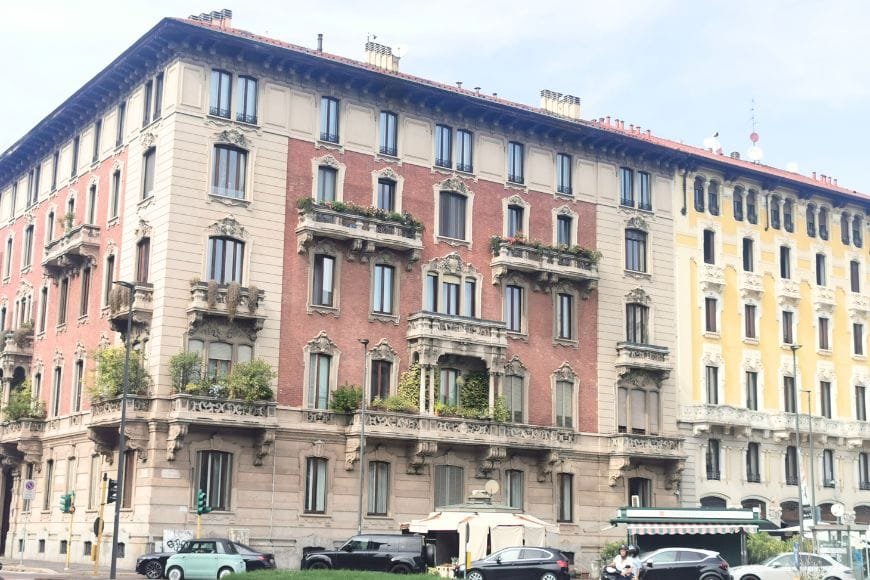
Look, I get it—figuring out where to stay in Milan can feel overwhelming. The city doesn’t have that obvious “this is THE neighborhood” vibe like some Italian cities do. When my friends ask me where they should book their hotel, my answer is always: “Well, what kind of trip are you taking?”
Here’s the thing about Milan: it’s not like Florence, where everything clusters around one pretty Renaissance center. Milan spreads out, and honestly? That’s what makes it interesting.
You’ve got the historic Duomo area (obvious choice, right?), but then there’s artsy Brera with its cobblestone charm, the canal-side Navigli that comes alive at night, and even modern glass-tower districts that feel nothing like “old Italy.”
I’ve stayed in probably six different Milan neighborhoods over the years—some by choice, some because I waited too long to book during Fashion Week (don’t make that mistake). And you know what I learned? There’s no single “best” area. The right neighborhood depends entirely on what you want from your Milan experience.
In this guide, I’m breaking down the best areas to stay in Milan based on actual experience—not just generic hotel website descriptions. I’ll tell you which neighborhoods work for first-timers, where to go if you’re on a budget, where the locals actually hang out, and which areas look good on paper but might disappoint in reality.
Whether you’re wondering where to stay in Milan for a quick weekend, planning a longer trip, or trying to balance convenience with authenticity, I’ve got you covered. Let’s find your perfect Milan neighborhood!
Don’t miss our Ultimate Milan Travel Guide (2025) — essential tips on when to visit, how to get around, and what to see before starting your itinerary.
Plan Your Stay: Recommended Hotels in Milan
Finding the right hotel can make your Milan experience smoother — whether you want to be near the train station for day trips from Milan or in a charming district for evening strolls.
Best Hotels in Milan
- 💰 Budget: B&B Hotel Milano City Center Duomo – Clean, central, and great value near major attractions.
- 🏙️ Mid-range: Hotel Spadari al Duomo – Boutique style with breakfast included, just steps from the cathedral.
- 💎 Luxury: Galleria Vik Milano – Art-filled rooms inside the stunning Galleria Vittorio Emanuele II.
Neighborhood Picks
- 🎨 Brera District: Romantic streets, art galleries, and elegant boutique hotels.
- 🌇 Navigli: Canal-side guesthouses, lively bars, and local trattorias.
- 🚆 Centrale: Perfect for travelers planning day trips to Lake Como, Verona, or Bergamo.
👉 Compare Milan hotel prices and book your stay here
👉 Find the best car rental deals on DiscoverCars.com if you plan to explore the lakes or vineyards.
Local Tip: Book early if you’re visiting during Fashion Week (Feb & Sept) or Design Week (April) — Milan fills up fast, and prices rise overnight.
Best Neighborhoods in Milan: Overview
Before we dive into specific areas, let me give you the lay of the land. Milan is divided by metro lines more than anything else—and trust me, you want to be near a metro stop. I learned this the hard way, staying in a “charming” Airbnb that required a 15-minute walk to the nearest station. In the summer heat. With luggage. Not fun.
Here’s how I think about Milan’s main neighborhoods:
The historic center (around the Duomo) is where first-timers usually stay. Makes sense—you can literally roll out of bed and be at Milan’s main attractions in minutes. But you’ll pay for that convenience, both in hotel prices and tourist-heavy vibes.
Brera sits just north and offers that sweet spot of charm plus accessibility. Think cobblestone streets, art galleries, and enough tourists that restaurants have English menus, but enough locals that you feel like you’re experiencing “real Milan.”
Porta Venezia is where I usually point budget-conscious friends. It’s residential, has a gorgeous park, and sits on the M1 metro line that gets you anywhere in 10-15 minutes. Less Instagram-pretty than Brera, but more authentic and affordable.
Navigli (the canal district) is Milan’s nightlife heart. Perfect if you’re in your 20s-30s and want evening energy. Less perfect if you value sleep or are traveling with kids.
Near Centrale Station isn’t winning beauty contests, but if you’re doing day trips to Lake Como or Bergamo, or you’re on a tight budget, the practicality can’t be beat. I’ve stayed here multiple times purely for the convenience factor.
Porta Nuova/Isola represents new Milan—skyscrapers, the famous Vertical Forest buildings, and a modern vibe that feels nothing like traditional Italy. Love it or hate it, but it’s undeniably well-connected and safe.
The key question to ask yourself: Are you prioritizing convenience to sights, local atmosphere, nightlife, budget, or something else? Once you know that, choosing your neighborhood becomes way easier. Milan’s metro system is efficient enough that you’re never truly “far” from anything—I can get from Porta Venezia to the Duomo in 12 minutes door-to-door.
My general rule: Stay near M1 (red line) or M3 (yellow line) if possible. These are the most useful metro lines for visitors, hitting all the major areas you’ll want to explore.
Milan Centro Storico (Historic Center)
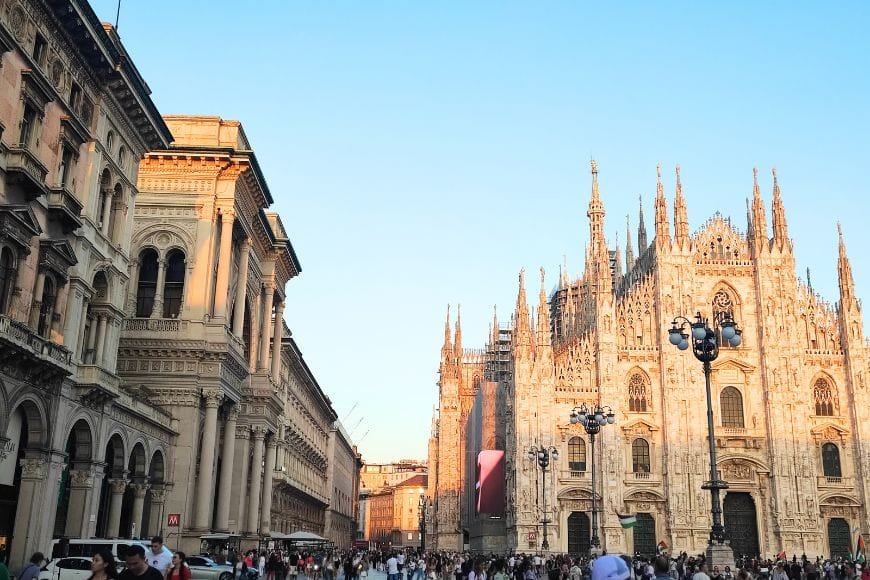
What It’s Like
Okay, let’s talk about staying right in the heart of it all—the area around the Duomo. This is peak tourist Milan, no sugarcoating it. You’ll hear multiple languages on every street corner, dodge selfie sticks on your way to breakfast, and pay €5 for an espresso if you’re not careful.
But here’s the thing: I totally get why people stay here, especially on their first Milan trip. Waking up and being a 5-minute walk from the Duomo? That’s pretty magical, even if I roll my eyes at the crowds. You can stumble out of your hotel half-asleep and still accidentally walk past world-famous landmarks.
Best For
This area makes sense if you’re:
- Visiting Milan for the first time and want maximum convenience
- Only here for 2-3 days (every minute counts!)
- Traveling with limited mobility—everything’s walkable, no metro navigation needed
- Someone who prioritizes location over budget
- The type who wants to say “I stayed steps from the Duomo” (no judgment, it IS cool)

Pros
Walking distance to literally everything major. Duomo, Galleria, La Scala, and even Castello Sforzesco is only 20 minutes on foot. I’ve had friends stay here, and they didn’t use the metro once in three days.
Restaurant and café options everywhere. You’re never more than 50 meters from food, coffee, or gelato. Granted, not all of it is great (avoid places with picture menus), but the sheer quantity of options is impressive.
Easy to orient yourself. The Duomo is your landmark. Lost? Walk toward the giant cathedral. It’s visible from everywhere in the center.
Public transport connections. Three metro lines (M1, M3, M5) converge at Duomo station. Trams and buses everywhere. You can get anywhere from here.
Cons
Most expensive area in Milan, hands down. I’ve seen hotel rooms here cost double what you’d pay 10 minutes away in Porta Venezia for similar quality. Budget €170+ for anything decent.
Tourist central means tourist nonsense. People trying to hand you “free” bracelets (not free), restaurants with pushy hosts outside, and that general feeling of being in Disney Italy rather than real Italy.
Crowded streets get old fast. The novelty of being in the thick of it wears off by day two when you’re trying to grab breakfast and there’s a tour group blocking the entire sidewalk.
Less authentic local atmosphere. You won’t find many actual Milanese living here. It’s hotels, offices, and shops catering to visitors.

What’s Nearby
I mean, everything? The Duomo literally defines “nearby” for the rest of Milan. Galleria Vittorio Emanuele II is attached. La Scala is a 5-minute walk. You can see Castello Sforzesco from certain hotel windows. The entire fashion district (Via Montenapoleone, Via della Spiga) is walkable.
Hotel Recommendations in Milan Historic Center
I’ll be honest—I rarely stay in the historic center because I find better value elsewhere. But when friends insist on this area, here’s what I tell them:
Luxury (€300+/night): If you’re splurging, get a room with a Duomo view. Otherwise, you’re paying premium prices for the same hotel experience you’d get cheaper elsewhere.
Mid-range (€150-300/night): Focus on side streets rather than directly facing the Duomo. Via Torino and the streets between Duomo and Castello offer slightly better value.
Budget (€80-140/night): Good luck. Seriously, budget hotels in this area are either far from the actual Duomo or pretty grim. Your money goes further in other neighborhoods.
👉 Find top-rated hotels in Milan Historic Center here
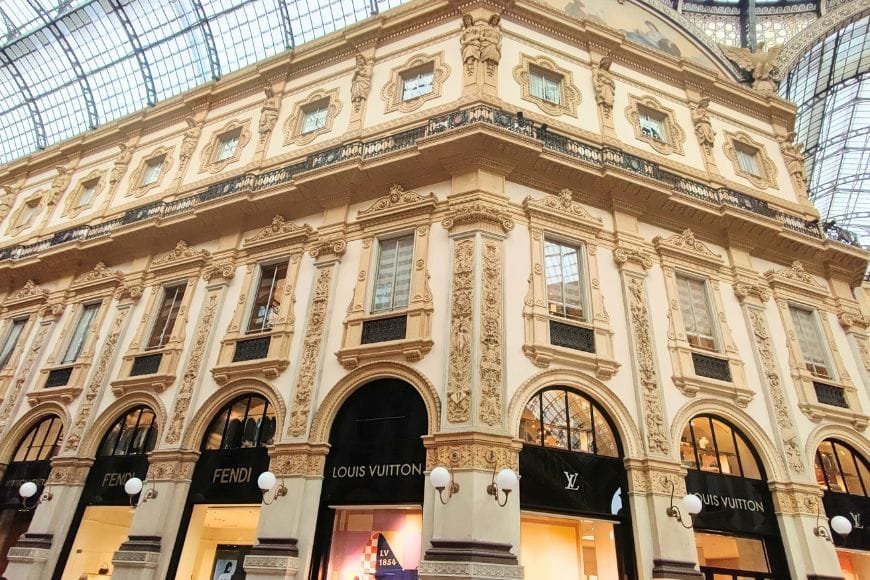
Insider Tips
If you’re set on staying here, here’s what I’ve learned:
Book months ahead, especially for Fashion Week (February/March, September/October) when prices literally triple. I’m talking €400/night for a basic room.
The north side of the Duomo (toward Castello) is quieter than the south side (toward Missori). Not by much, but enough that you might actually sleep past 7 am.
Side streets offer better value than hotels directly facing the Duomo or on Corso Vittorio Emanuele. You’re still a 3-minute walk from everything, but might save €80/night.
Skip hotel breakfast unless it’s included—you’ll find better coffee and cornetti at local bars for €3 instead of €15-20 hotel buffets.
My honest take? If this is your first time in Milan and you’re only here 2-3 days, the convenience can justify the cost and crowds. You’ll maximize your time without worrying about metro schedules. But if you’re staying longer, have been to Milan before, or are on any kind of budget, I’d seriously consider other neighborhoods. You’re paying a premium for location when Milan’s metro can get you here in 10 minutes from way more interesting areas.
Brera

What It’s Like
Ah, Brera. This is the Milan neighborhood I romanticize the most, probably because I had an incredible weekend here once, and the weather was perfect, and the Aperol Spritz tasted better than usual. But honestly, even on regular visits, Brera just has something.
Picture cobblestone streets (yes, actual cobblestones—bring comfortable shoes), art galleries tucked into centuries-old buildings, ivy climbing up ochre-colored walls, and that kind of effortlessly elegant vibe that makes you want to buy a linen scarf and suddenly care about contemporary art. It’s touristy, sure, but in a more sophisticated way than the Duomo area. Like, you’ll overhear conversations about gallery openings rather than just “where’s the Gucci store?”
The neighborhood centers around the Pinacoteca di Brera (art museum) and radiates out in a maze of charming streets that are genuinely fun to get lost in. I’ve walked the same route through Brera a dozen times and still discover new corners.
Best For
Brera clicks with:
- Art lovers (obviously—you’re surrounded by galleries)
- Couples looking for a romantic atmosphere without Navigli’s party energy
- Food enthusiasts who want excellent restaurants within stumbling distance
- Anyone wanting charm AND convenience—you get both here
- People who Instagram their travels (sorry, but it’s true—Brera photographs beautifully)
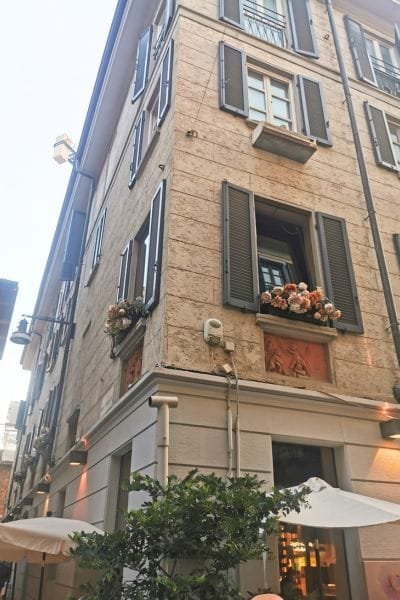
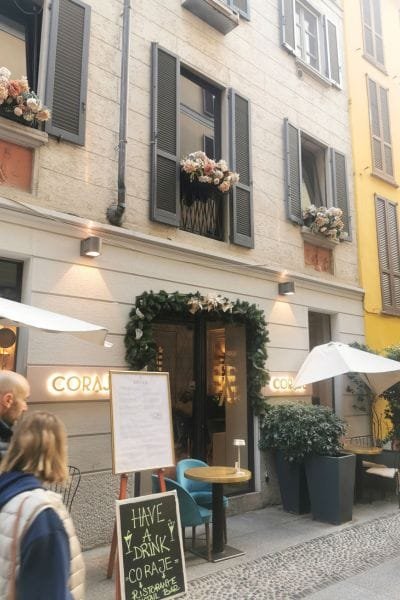
Pros
Character in spades. This feels like a real historic Milan neighborhood that happens to welcome visitors, rather than existing purely for tourism. I see actual Milanese here—artists, gallery owners, elderly locals who’ve lived here for decades.
The restaurant scene is outstanding. Some of my favorite Milan meals have happened in Brera. The concentration of good trattorias, wine bars, and cafés here beats most other neighborhoods. Via Fiori Chiari especially has gems.
Still walking distance to major sights. The Duomo is 15 minutes on foot. Castello Sforzesco is even closer. You get the convenience without sleeping next to a tour bus parking lot.
The Brera Art Gallery is right here if you’re into Italian Renaissance and Baroque art. Even if you skip the museum, the courtyard with the Napoleon statue is free and gorgeous.
Feels safe and welcoming at all hours. I’ve walked through Brera at midnight and always felt comfortable. It’s well-lit and usually has people around.
Get our FREE Italy
Travel Guide
E-Book
This printable guide is your ultimate companion for exploring Italy, with insider tips, detailed itineraries, transportation advice, must-see attractions, and more.

Cons
Expensive, though slightly less brutal than Centro Storico. You’re still paying a premium for the location and atmosphere. Budget €170-300/night for decent hotels here.
Tourist crowds around Piazza Brera can get annoying, especially weekend afternoons when everyone’s doing the same Instagram photo circuit. The main streets get packed.
Some streets get loud in the evenings when bars and restaurants fill up. If you’re a light sleeper, request a room on a quieter side street or facing an interior courtyard.
Limited metro access. There’s no metro station directly in Brera—you’re between M2 (Lanza or Moscova) and M3 (Montenapoleone). It’s walkable to all of them, but not as convenient as being right on top of a station.
What’s Nearby Brera

The Pinacoteca di Brera art museum is the neighborhood’s centerpiece—world-class Italian art if that’s your thing. The Brera Botanical Garden (Orto Botanico) is a free, peaceful escape that most tourists walk right past—I always pop in when I’m in the area.
Via Solferino and Via Pontaccio have interesting boutiques and vintage shops. Corso Como is a 10-minute walk north—the famous 10 Corso Como concept store is there, along with design-focused shops.
You’re also close to San Maurizio al Monastero Maggiore, that incredible church with floor-to-ceiling frescoes that locals call “Milan’s Sistine Chapel” (it’s free and way less crowded than the actual Sistine Chapel, just saying).

Hotel Recommendations in Brera
Brera is dominated by boutique hotels rather than chains, which I actually love—each property has personality.
When friends book here, I tell them to look for:
- Boutique properties on side streets (Via Fiori Chiari, Via Madonnina, Via Pontaccio)
- Places with courtyard or interior-facing rooms if noise concerns them
- Hotels with rooftop terraces—some Brera hotels have secret rooftop bars with amazing views
Expect to pay €150-300/night for mid-range boutique hotels. Luxury options push €300+. Budget options barely exist here—if you find something under €120, read reviews very carefully.
👉 Find the best hotels in Brera area here
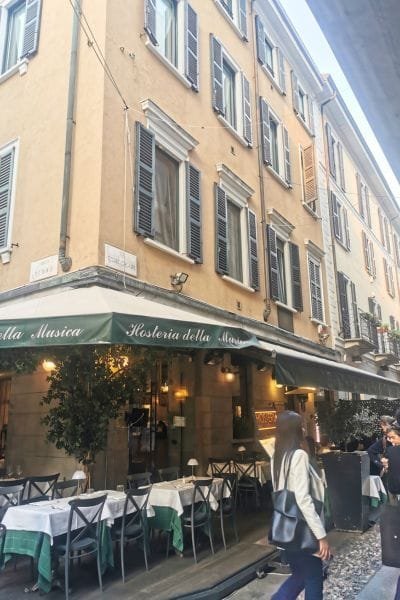

Insider Tips
Stay on the quieter northern side of Brera (toward Moscova metro) if you want charm without the tourist concentration. Via Pontaccio and that area feel more residential.
Via Fiori Chiari is magic—this street has beautiful buildings, great restaurants, and that “am I in a movie?” vibe. If your hotel is here, you won’t regret it.
The Brera Botanical Garden is my secret recommendation. It’s free, it’s beautiful, and 90% of tourists have no idea it exists. Perfect for a quiet moment between sightseeing.
Book restaurants ahead if you want to eat in Brera—the good spots fill up, especially Thursday-Saturday nights. I’ve had friends wing it and end up at mediocre tourist traps because everything else was full.
Wednesday and Saturday mornings, there’s a small organic market in the Brera courtyard. Nothing huge, but a nice slice of local life.
My honest assessment? Brera is where I’d stay if money weren’t an object and I wanted to feel like I was living in “beautiful Milan” rather than just visiting. It’s romantic without being contrived, convenient without being crowded (well, mostly), and has enough good restaurants that you could eat differently every night for a week.
The price premium over, say, Porta Venezia is real—maybe €40-50 more per night. Whether that’s worth it depends on your budget and priorities. For a special trip or if you’re only in Milan 2-3 days, I think it absolutely is. For longer stays or budget travel, you might prefer spending that money on great dinners instead of hotel location.
Porta Venezia

What It’s Like
Okay, Porta Venezia is where I actually tell most of my friends to stay—especially if they’re doing more than a quick weekend trip or watching their budget. This is what I call “real Milan”—a residential neighborhood where actual Milanese people live, work, and do their grocery shopping.
The area radiates out from Porta Venezia metro station (M1 red line—crucial detail) and stretches toward Corso Buenos Aires, one of Milan’s longest shopping streets. You’ll see more locals than tourists, more Italian spoken than English, and prices that won’t make you weep. It’s not going to blow your mind with Renaissance charm, but it’s got something better: authenticity and convenience at reasonable prices.
The architecture here is actually quite beautiful if you look up—lots of Liberty style (Italian Art Nouveau) buildings from the early 1900s with those gorgeous decorative facades. Via Malpighi and the streets around there have some real gems. Plus, you’re right next to the Giardini Pubblici, Milan’s oldest public park, which I love for morning walks.
Best For
Porta Venezia works beautifully for:
- Budget-conscious travelers who still want good metro access
- Families (the park with playgrounds is right here)
- Longer stays—the neighborhood has everything you need for daily life
- People who want to feel like they’re experiencing local Milan rather than tourist Milan
- Anyone prioritizing value and convenience over Instagram-worthy charm

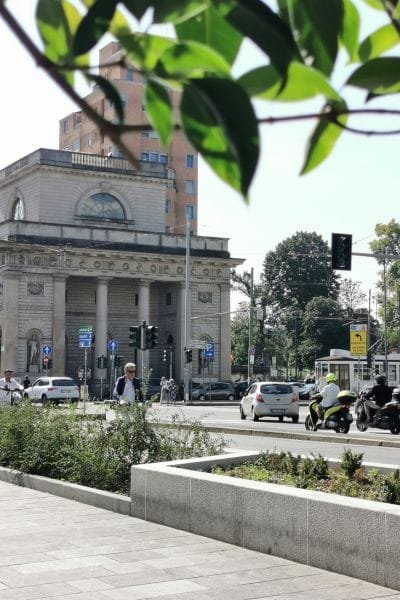
Pros
More affordable without sacrificing convenience. I’m talking €80-150/night for decent accommodations versus €150-250+ in Brera or Centro Storico. That’s real money saved over a week-long trip.
Excellent metro access on M1 (red line). You can reach the Duomo in literally 7-10 minutes. Castello Sforzesco is 3 stops. It’s connected enough that you never feel far from anything.
Giardini Pubblici right here—beautiful public gardens perfect for morning coffee, afternoon reading, or letting kids burn energy at the playgrounds. The Natural History Museum is in the park too, if you’ve got dinosaur-obsessed children.
Great restaurants that aren’t tourist traps. The density of good, affordable places to eat here beats most other neighborhoods. I’m talking €14-22 for full meals at places where locals actually dine. Corso Buenos Aires and the side streets have everything from pizza to Chinese to traditional Italian.
A real neighborhood feel means you’ll see everyday Milan life. Markets, locals walking dogs, elderly Milanese chatting on park benches, kids going to school. It’s not staged for visitors.
Multicultural vibe adds character—there’s a significant Asian and Middle Eastern community here, meaning excellent international restaurants and an interesting cultural mix you don’t get in more touristy areas.
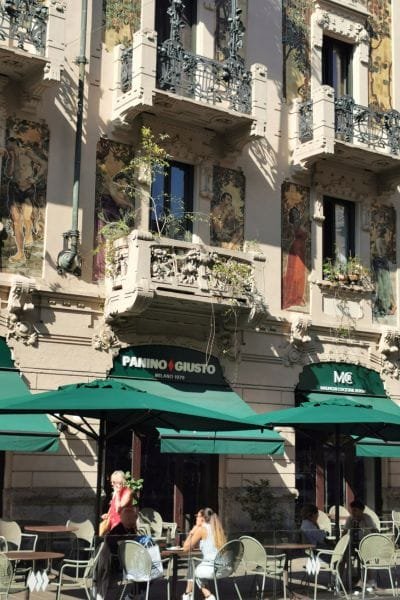
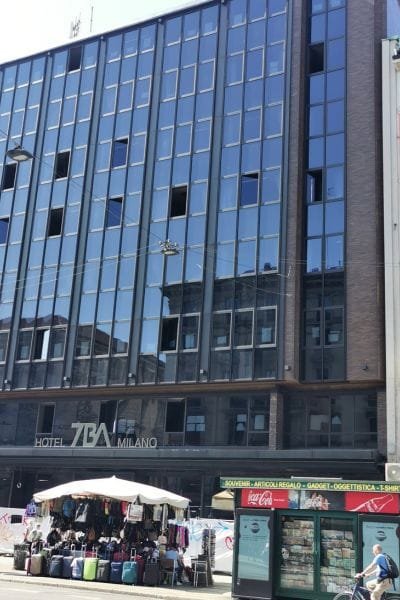
Cons
Not as immediately charming as Brera or the historic center. You won’t walk out your door and gasp at beauty. It’s a regular, lived-in neighborhood—which I love, but not everyone does.
15-20 minute walk or metro ride to major sights. This doesn’t bother me at all since Milan’s metro is so efficient, but if you’re set on rolling out of bed and being at the Duomo, this isn’t it.
Fewer hotel options, more apartments. The accommodation landscape here skews toward Airbnbs and apartment rentals rather than traditional hotels. Not necessarily a con, but worth knowing.
Less nightlife energy than Navigli or Brera. This is a residential area—people live and sleep here. Great for rest, less great if you want bars and clubs at your doorstep.
What’s Nearby Porta Venezia
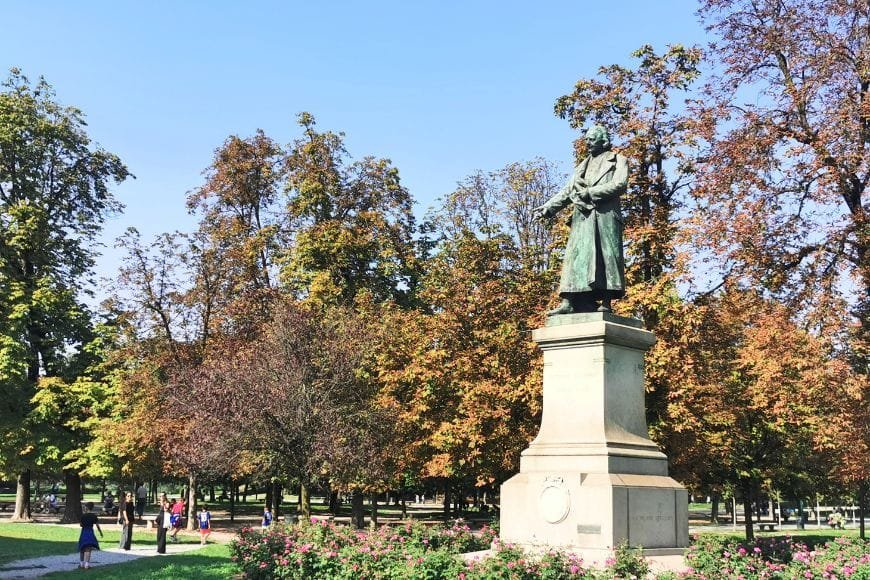
The Giardini Pubblici and Villa Reale gardens are the neighborhood’s crown jewel. The Natural History Museum sits inside the park (great for kids). Corso Buenos Aires is one of Europe’s longest shopping streets—every chain store exists here, plus local boutiques.
Via Lincoln (the rainbow street with colorful buildings) is a 5-minute walk and makes for fun photos. The Porta Venezia gate itself—the actual historic gate—is worth seeing.
You’re also close to the Politecnico (university), which means good, cheap student restaurants if you know where to look.
Accommodation Options in Porta Venezia
Porta Venezia has more apartments than traditional hotels, which I actually think is perfect for this neighborhood. Having a kitchen in a residential area means you can shop at local markets and cook, a very different experience from hotels in tourist zones.
Expect €80-100/night for decent one-bedroom apartments, €90-150 for nice hotel rooms. There are some boutique hotels along Corso Buenos Aires and side streets that offer good value.
Ostello Bello has a location here if you’re on a serious budget—one of Milan’s best hostels with dorm beds around €38-48.
👉 Compare Porta Venezia hotel prices and book your stay here

Insider Tips
Stay near the M1 Porta Venezia or Palestro stops—both work perfectly. Avoid going too far east toward Loreto unless you’re really budget-focused.
Corso Buenos Aires for shopping—if you need normal stuff (clothes, shoes, pharmacy), this street has literally everything and none of it is designer-priced.
Sunday mornings in the park are peak Milanese family life—grab a coffee and do some people-watching. It’s lovely.
The area around Via Melzo has several good aperitivo spots that are way cheaper and less touristy than Navigli or Brera.
My take? Porta Venezia is the smart choice for most travelers. You save money, experience authentic Milan, have excellent metro connections, and can still reach all the major sights easily. It’s not going to give you postcard-perfect streets outside your window, but it’ll give you a genuine sense of how Milanese actually live. For me, that’s way more valuable.
Perfect! Here’s Navigli at 700 words:
Navigli
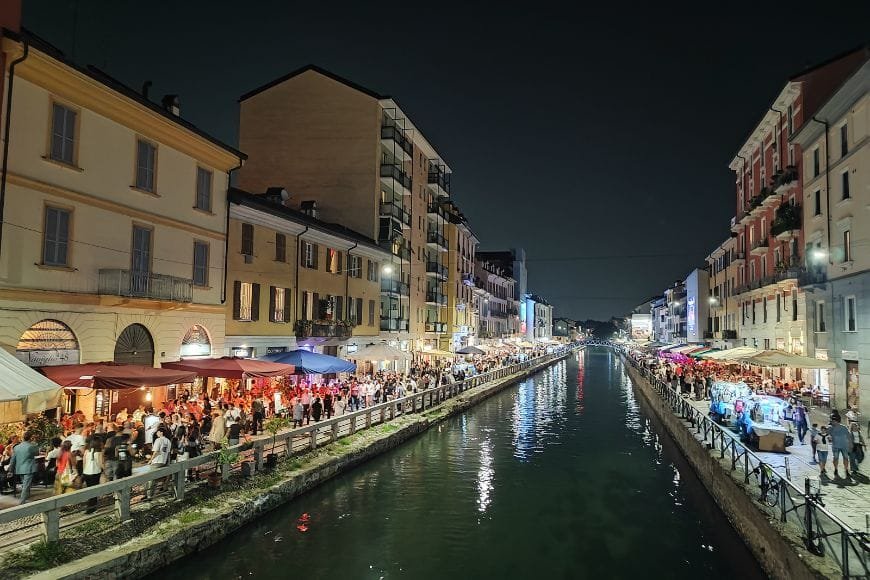
What It’s Like
Navigli is Milan’s party neighborhood, and I mean that in the best way possible. This is the canal district—yes, Milan has canals, surprise!—and it’s where the city comes alive at night. Think outdoor seating along waterways, vintage shops spilling onto sidewalks, street musicians on every bridge, and that perfect golden hour light bouncing off the water that makes every aperitivo taste better.
The neighborhood centers around Naviglio Grande (the big canal) and Naviglio Pavese, with the action concentrated along the waterfront paths. By day, it’s charming but quiet. By evening, it transforms into Milan’s social hub—everyone from students to professionals to tourists converges here for drinks, dinner, and that buzzy energy that makes you want to stay out way later than planned.
I love Navigli, but I’m also honest about what it is: not for everyone. If you’re in your 20s or 30s and want to be where things are happening, this is your spot. If you’re seeking peace and quiet, look elsewhere.
Best For
Navigli works if you’re:
- Young travelers or couples who prioritize nightlife and atmosphere
- Weekend visitors who want maximum evening energy
- Social butterflies who like being where the action is
- Vintage shopping enthusiasts—the Sunday antique market here is legendary
- People who value character over convenience to major sights
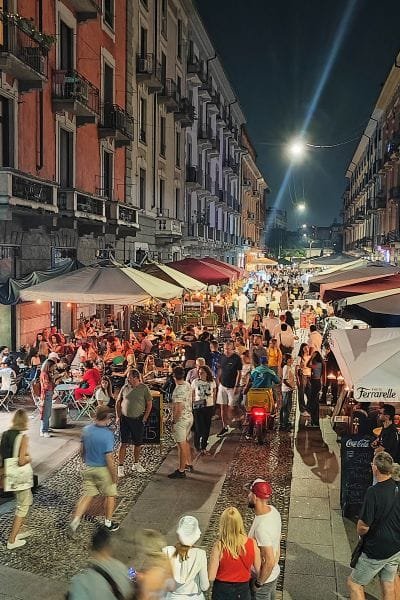
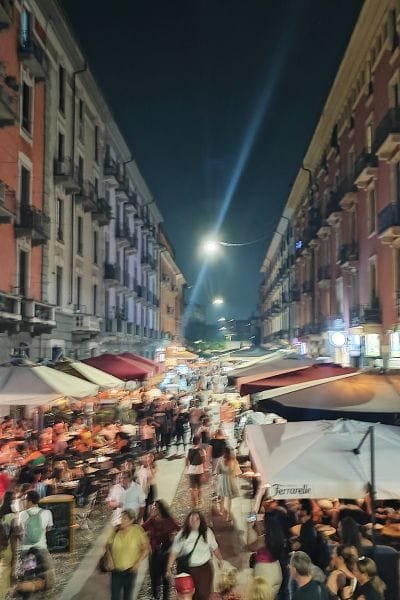
Pros
The aperitivo scene is unmatched. This is literally where Milanese come for drinks and the tradition of aperitivo—pay €8-12 for a drink, eat from unlimited buffets. I’ve had entire dinners this way while sitting along the canal watching the world go by.
Unique atmosphere you won’t find elsewhere in Milan. The canals give it personality that the Duomo area or modern Porta Nuova simply can’t match. It feels bohemian and artistic in a way that’s increasingly rare in expensive Milan.
Excellent restaurants line the canals. Yes, some are tourist traps, but plenty of locals eat here too. The concentration of good dining options—from traditional Italian to international—is impressive.
The Sunday antique market (last Sunday of each month) along Naviglio Grande is one of Milan’s best. I’ve spent entire mornings here browsing vintage everything—furniture, books, jewelry, random treasures. Even if you don’t buy anything, it’s a great atmosphere.
Vintage shopping during the week, too. The streets along the canals have excellent vintage clothing stores, used bookshops, and quirky boutiques. Way more interesting than mainstream shopping districts.
Real neighborhood beyond the canals. Walk one block off the main waterfront and you’ll find residential streets with local bakeries, hardware stores, and everyday Milan life. It’s not all bars and tourists.
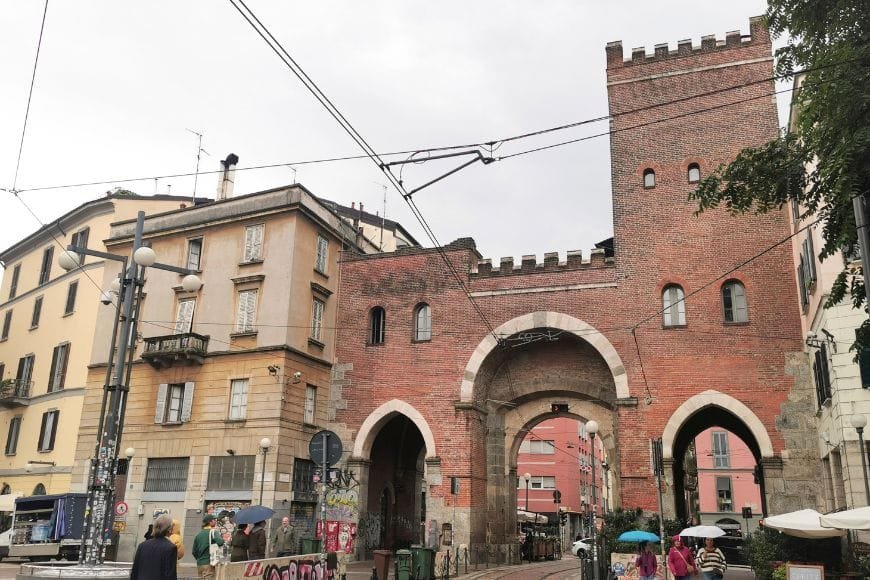
Cons
Noisy, especially Thursday-Sunday nights. If you book accommodation directly on the canals, expect to hear people, music, and general revelry until midnight or later. I stayed here once on a Saturday and barely slept. Learned my lesson.
Farther from major tourist sights—you’re looking at 20-30 minutes to reach the Duomo, either by walking or by metro, plus walking. It’s not terribly far, but definitely not “roll out of bed and you’re there” convenient.
Limited metro access. The M2 green line stops at Porta Genova, but from there you still walk 10-15 minutes to reach the actual canal area. It’s not a deal-breaker, but it’s less convenient than areas with multiple metro lines.
The party atmosphere isn’t for everyone. If you’re traveling with kids, exhausted from work and need rest, or just prefer quiet evenings, Navigli will drive you insane. I love it, but I’m self-aware about who I’m recommending it to.
Can feel touristy along the main canal, especially on summer evenings when it’s absolutely packed. The crowds rival anything at the Duomo.
What’s Nearby Navigli

The Naviglio Grande and Naviglio Pavese canals define the neighborhood. Colonne di San Lorenzo—ancient Roman columns where locals hang out—is nearby. Porta Ticinese, with its medieval gate, is walkable.
The Basilica di San Lorenzo is one of Milan’s oldest churches, right in the area. The entire Ticinese district, with vintage shops and alternative vibes, connects to Navigli.
You’re also reasonably close to MUDEC (Cultures Museum) if that interests you.
Accommodation Options in Navigli
Navigli has a mix of boutique hotels, hip hostels, and Airbnb apartments. The style here tends toward trendy and design-focused rather than traditional Italian elegance.
Expect €90-150/night for decent hotels, with boutique options pushing €170-300. There are some good hostels for budget travelers in the €40-50 range.
Critical booking tip: Request rooms AWAY from the main canals if you value sleep. Interior courtyard rooms or accommodations on side streets will save your sanity.
👉 Compare Navigli hotel prices and book your stay here
Insider Tips
Book one block off the canals for all the atmosphere with less noise. Streets like Via Corsico or Via Vigevano are close enough to walk to the action in 2 minutes, but far enough that you can actually sleep.
The Sunday antique market requires getting there by 10 am for the best finds. By noon, locals have picked through everything good.
Via Corsico and side streets have better restaurant value than the canal-front places. Same food, €5-8 less per meal.
Weeknight Navigli (Monday-Wednesday) offers the atmosphere without the crushing crowds. I actually prefer it—you can get tables without reservations and hear your dinner conversation.
My honest take? Navigli is perfect for the right traveler at the right time. Young couple on a romantic weekend? Book here, embrace the energy, stay out late, soak it all in. Family with kids? Hard pass—you’ll be miserable. Solo traveler who loves social atmosphere? Great choice. Business traveler needing rest? Absolutely not.
I’d stay here for 2-3 nights max, enjoying the evening scene, then I’d probably want somewhere quieter. It’s not a neighborhood for long-term stays unless you’re very social and don’t need much sleep. But for capturing that vibrant, social Milan energy? Nothing beats it.
Near Milan Centrale Station

What It’s Like
Let me be honest: the area around Milano Centrale station isn’t going to win any beauty contests. It’s gritty, urban, busy, and has that slightly chaotic energy that comes with being around a major transport hub. I’ve walked past the same sketchy-looking characters loitering outside the station enough times that I recognize them now.
BUT—and this is important—it’s also incredibly practical, surprisingly safe despite appearances, and significantly cheaper than staying in prettier neighborhoods. I’ve stayed near Centrale probably five or six times, always for the same reasons: I was doing day trips, arriving late or leaving early, or just wanted to save money for excellent dinners instead of fancy hotel locations.
The neighborhood is essentially the blocks surrounding Milano Centrale station, Milan’s massive main train station that looks like a Fascist-era monument (because it is). You’re in a business/residential area with chain hotels, international restaurants, and that generic big-city feeling. Not romantic. Not charming. But functional as hell.
Best For
Near Centrale makes sense if you’re:
- Doing day trips to Lake Como, Bergamo, and Verona—you’ll appreciate being 5 minutes from the station
- Arriving late or leaving early—no stressing about metro schedules or taxi costs
- Budget-focused travelers—this is Milan’s best value area for decent hotels
- Business travelers who prioritize convenience over atmosphere
- Solo travelers who’ll spend most time exploring other areas anyway

Pros
Walking distance to Centrale station is the whole point. I can’t overstate how convenient this is if you’re taking trains anywhere. Roll out of bed at 8:30 am, grab coffee, catch your 9 am train to Como. No rush, no stress.
Excellent metro connections—M2 (green line) and M3 (yellow line) both stop at Centrale. You can reach any part of Milan easily. The Duomo is 10-12 minutes away on M3.
Significantly cheaper hotels than in other areas. I’m talking €80-120/night for rooms that would cost €150-250 in Brera. That’s serious budget savings that add up over multiple nights.
Every price range available—from €35 hostel beds to €150 business hotels to €200+ luxury chains. The accommodation density here is huge, so you have options.
Corso Buenos Aires (Milan’s longest shopping street) is a 10-minute walk, connecting you to Porta Venezia and beyond. So you’re not completely isolated from interesting neighborhoods.
Practical amenities everywhere—supermarkets, pharmacies, cheap restaurants, McDonald’s (don’t judge, sometimes you need familiar food), currency exchange, everything you might need.
Cons
Not scenic or atmospheric. You’re staying here for function, not Instagram photos. The streets around the station are busy, concrete-heavy, and lack charm. This is Milan’s business side, not its beautiful side.
Sketchy vibe, especially at night. The immediate area around Centrale station has some characters—nothing dangerous, just uncomfortable. Drunk people, aggressive panhandlers, that sort of thing. I’m a reasonably experienced traveler, and I walk purposefully here at night, staying aware.
Farther from tourist sights than central areas—though “far” is relative. You’re 15-20 minutes by metro to the Duomo, which honestly isn’t bad. But it’s not “walk everywhere” territory.
Less character and local feel. This is generic international big-city territory. You could be near any major train station in Europe. It doesn’t feel distinctly Milanese.
Get our FREE Italy
Travel Guide
E-Book
This printable guide is your ultimate companion for exploring Italy, with insider tips, detailed itineraries, transportation advice, must-see attractions, and more.

What’s Nearby Milan Train Station
Honestly? The train station IS what’s nearby, which is the point. But Corso Buenos Aires starts here—one of Europe’s longest shopping streets with literally every store imaginable. Porta Venezia neighborhood and its beautiful park are a 10-15 minutes walk.
Isola district (creative neighborhood with street art) is also walkable from here, about 15 minutes. And obviously, anywhere in Milan is reachable via the metro stop at the station.
Accommodation Options Near Milan Train Station
This is probably Milan’s densest accommodation area. You’ve got:
International chain hotels (Hilton, NH, Starhotels, etc.) in the €150-200 range—reliable, boring, clean.
Budget hotels lining Via Vitruvio, Via Tonale, and surrounding streets for €90-120/night. Quality varies wildly—read recent reviews carefully.
Hostels—Ostello Bello Grande is here, and it’s one of Milan’s best hostels. Dorm beds €40-50, private rooms available, rooftop bar, social atmosphere.
Airbnb apartments, if you want a kitchen and more space for the same money as a hotel room.
👉 Find top-rated hotels near Milan train station here
Plan Your Trip with Our Favorite Booking Tools
Insider Tips
Prioritize streets like Via Vitruvio or Via Tonale—they’re close to the station (5-7 minute walk) but one block removed from the immediate chaos. I’ve stayed on Via Vitruvio twice and found it perfectly fine.
The station itself is safe—it’s crowded with travelers, has police presence, and is well-lit. It’s the surrounding streets late at night where you want to stay alert. Just walk with purpose, and you’ll be fine.
There’s a Carrefour supermarket in the station itself, plus tons of cheap restaurants (Chinese, kebab, pizza) on the surrounding streets. You can eat well for €8-15 per meal.
Use the left luggage service at Centrale if you’re doing a day trip—it’s like €6 for the day and saves you hauling bags around Lake Como.
Don’t book hotels MORE than 10-15 minutes walk from the station. At that point, you’ve lost the convenience advantage and you’re just staying in a random neighborhood with no particular appeal.
My take? Near Centrale is the unglamorous but smart choice for specific situations. I stayed here for four nights once while doing day trips to Como, Bergamo, and Verona—it was perfect. I didn’t care that the neighborhood was bland because I was barely there. I saved probably €200 over staying in Brera, which paid for all my day trip trains and nice dinners.
But would I stay here for a romantic weekend or a first-time Milan visit where I’m focusing on the city itself? Probably not. I’d rather pay more for Brera or Porta Venezia and feel like I’m actually IN Milan rather than camped at the train station.
It’s all about priorities. Centrale area is a tool—use it when it makes sense, skip it when it doesn’t.
Porta Nuova / Isola
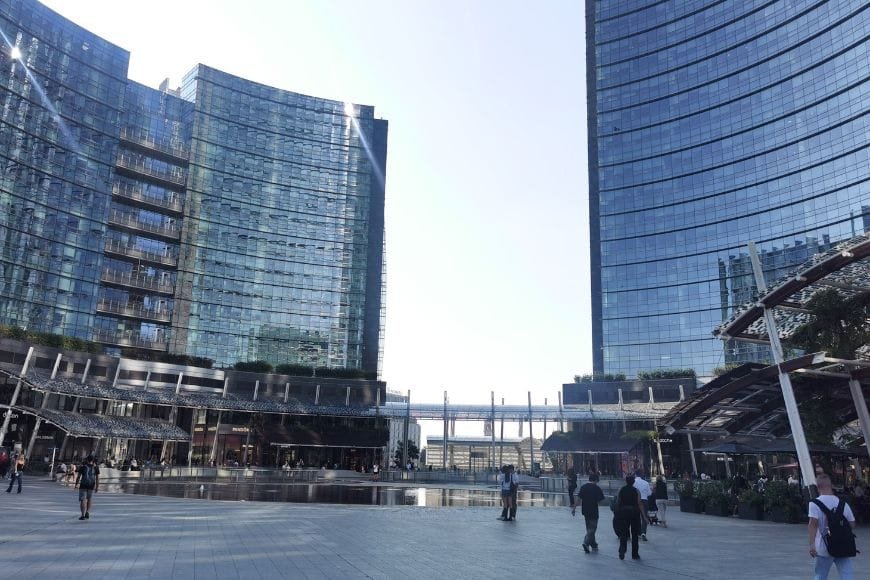
What It’s Like
Porta Nuova is where Milan shows off its modern side—and honestly, it’s kind of jarring if you’re expecting old Italian charm. We’re talking glass skyscrapers, the famous Bosco Verticale (Vertical Forest buildings covered in trees), sleek corporate towers, and that polished, almost sterile feeling of brand-new urban development.
I have mixed feelings about this area. On one hand, it’s undeniably impressive from an architecture and urban planning perspective. On the other hand, it feels nothing like traditional Italy. You could be in any modern global city—Singapore, Dubai, or Toronto. Some people love that contrast; others find it soulless.
Isola, the neighborhood on the north side of Porta Nuova, has way more character. This is where the creative types, artists, and young professionals have clustered. The streets here have amazing street art murals, independent cafés, and that slightly gritty-but-cool vibe that happens when an old working-class neighborhood gets discovered by the creative class.
Best For
This area works if you’re:
- Design and architecture enthusiasts who want to see Milan’s contemporary side
- Business travelers staying in the corporate towers
- Instagram photographers—Bosco Verticale and modern architecture are very photogenic
- People who prefer modern, clean environments over historic charm
- Fans of street art (Isola specifically)
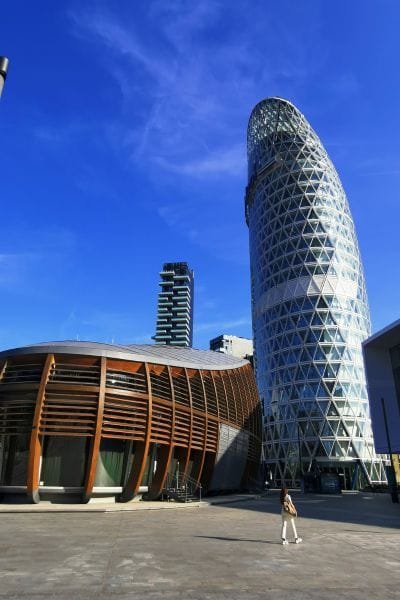
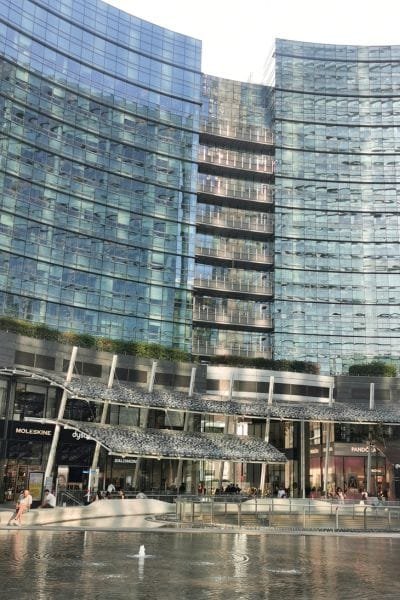
Pros
Contemporary, clean, safe feeling. Everything here is new or recently renovated. Wide sidewalks, modern buildings, well-lit streets. If you like order and contemporary design, you’ll appreciate this.
Excellent metro connections—M2 and M5 both stop at Garibaldi station, which is incredibly convenient. You can reach anywhere in Milan easily. The Duomo is 15 minutes away.
BAM park (Biblioteca degli Alberi) is one of Milan’s newest and nicest parks—contemporary landscape design, water features, kids can play in during summer, events, and activities. It’s a lovely green space for a modern neighborhood.
Trendy restaurants and bars have moved into the area, especially around Isola. Some genuinely good spots mixing Italian and international cuisine. The food scene here is more adventurous than traditional trattorias elsewhere.
Isola neighborhood specifically has incredible street art—massive murals covering entire building facades. Artists like Orticanoodles have transformed this area. I’ve spent hours just wandering and photographing.
Safe at all hours. The corporate presence and new development mean this area feels very secure. I’ve walked through late at night and never felt uncomfortable.
Cons
Expensive hotels because everything’s new and “luxury.” You’re looking at €180-250+/night minimum. The budget options that exist in older neighborhoods simply aren’t here yet.
Lacks Italian character and soul. This is modern global-city Milan, not the Milan of aperitivo traditions and historic churches. If you came to Italy for “Italy,” this isn’t it.
Can feel sterile and empty outside business hours, especially on weekends. The corporate towers empty out, and suddenly this gleaming district feels a bit lifeless. Isola’s side is better for this.
Not near major historic attractions. You’re not walking to the Duomo or Castello from here—you’ll need the metro. It’s well-connected, but still requires transit.
Restaurant prices are generally high in the Porta Nuova core area because it is a new and corporate district. You’ll find better value in neighboring Isola streets.
What’s Nearby Porta Nuova
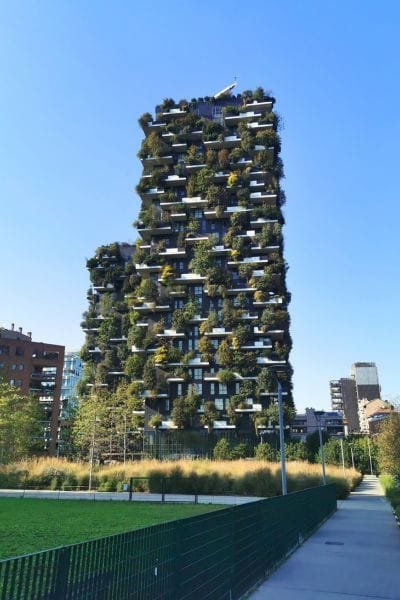

Bosco Verticale (Vertical Forest) are those stunning residential towers covered in plants—one of Milan’s most iconic modern structures. You can’t go inside (they’re private apartments), but the exterior is impressive.
BAM park (Biblioteca degli Alberi) offers 10 hectares of contemporary parkland with walking paths, water features, and events. Very different from historic Milan parks, but beautiful in its own right.
Isola district streets around Via Pola and Via Borsieri have the street art, cafés, and a local character. Corso Como is nearby—the famous 10 Corso Como concept store is walkable from here.
Piazza Gae Aulenti is the central plaza surrounded by skyscrapers—kind of cool in a modern urban way, though it also feels very corporate.
Accommodation Types in Porta Nuova
This area has modern hotels—both international chains and design-focused boutique properties. Everything skews contemporary rather than historic charm.
Expect €180-250/night for mid-range modern hotels, with luxury options pushing €350+. I haven’t found budget options here worth recommending—if budget is your priority, other neighborhoods make more sense.
👉 Check out the top-rated hotels in Milan Porta Nuova here
Insider Tips
Stay on the Isola side rather than in the corporate tower zone if you want more neighborhood character and better food options. You’re still close to everything, but get a more authentic atmosphere.
Garibaldi station has excellent connections—both M2 (green line) and M5 (purple line). This makes the area surprisingly convenient despite being north of the center.
BAM Park hosts free events, outdoor movies, and activities—check their calendar if you’re visiting in summer. It’s more programmed and active than traditional Milan parks.
The area around Via Pola in Isola has the best street art and local cafés. This is where I’d spend my time rather than in the corporate towers.
Frida café in Isola is my favorite—bookshop/café with excellent coffee, vegan food options, and a completely local crowd. It’s the kind of place that reminds you this is still Milan, not just a modern business district.
My honest assessment? Porta Nuova/Isola is for specific travelers. If you’re doing business here or you genuinely love contemporary architecture and want to see Milan’s modern side, it works perfectly. The area is safe, clean, well-connected, and has good restaurants.
But if you’re visiting Milan to experience Italian culture, history, and charm—which is why most people come—I’d skip this for Brera, Porta Venezia, or even Navigli. You can easily visit Porta Nuova on a day trip to see Bosco Verticale and walk through BAM park without committing to sleeping here.
The exception is Isola proper—that neighborhood has character and creativity that’s genuinely interesting. If you found accommodation on the Isola side that wasn’t too expensive, I’d consider it. But the gleaming corporate tower zone? That’s a hard pass unless you have specific reasons.
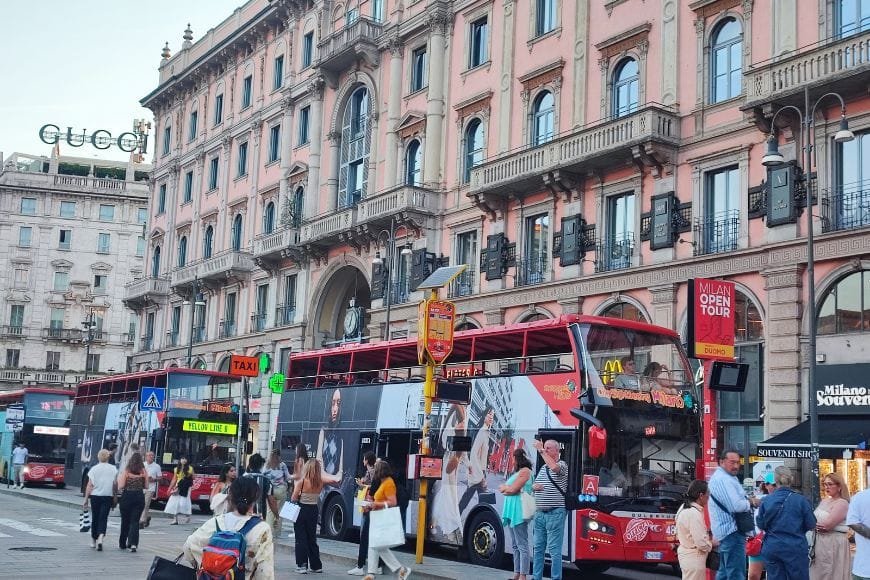
Other Areas Worth Considering
Look, I’ve covered the main neighborhoods tourists typically consider, but Milan has other areas that might actually suit you better depending on your priorities. These aren’t usually on the radar, but they shouldn’t be completely dismissed.
Porta Romana
I have a soft spot for Porta Romana because it feels genuinely residential while still being well-connected. This is south of the historic center, and it’s where you’ll find everyday Milan life happening without much tourist presence at all.
The neighborhood centers around the Porta Romana metro stop (M3 yellow line), which gets you to the Duomo in literally 8 minutes. You’ve got the Rotonda della Besana here—a beautiful circular building that houses MUBA children’s museum, plus nice gardens. The area has excellent restaurants that cater to locals rather than tourists, meaning better food at lower prices.
When to choose Porta Romana: You’re staying longer than a few days, you want an authentic neighborhood atmosphere, and you’re budget-conscious but still want decent metro access. I’d stay here for a week-long trip without hesitation.
What to expect: €80-100/night for apartments and mid-range hotels. Lots of residential buildings, local bars, regular supermarkets—nothing fancy, just real Milan life.
Città Studi (University Area)
This is Milan’s main university district, east of the center, around Piola metro stop (M2 green line). If you’ve ever stayed in a university town anywhere, you know exactly what to expect: cheap food, young energy, affordable accommodation, and that slightly chaotic student atmosphere.
I stayed here once when everything else was fully booked during Fashion Week, and you know what? It was fine. Not exciting, not beautiful, but perfectly functional and SO much cheaper than anywhere else.
When to choose Città Studi: Your budget is seriously tight, you’re a student yourself, or you’re staying long-term and want rock-bottom prices. Also good if you don’t mind a 20-25 minute commute to major sights.
What to expect: €40-80/night for basic hotels and apartments. Tons of cheap restaurants—pizza, kebabs, university canteens offering €8-12 full meals. It’s not charming, but your money goes twice as far here.
Big caveat: This area basically shuts down in August when students leave for the summer. If visiting then, it’ll feel dead.
Lambrate
Lambrate is east Milan’s design and creative district—or at least, it’s trying to be. The neighborhood has post-industrial vibes with converted warehouses, design studios, and that “next up-and-coming area” feeling. During Milan Design Week (April), this becomes a major hub for off-site exhibitions.
I’ll be honest: I haven’t stayed here personally, but I have friends who love it for longer stays because you get way more space for your money in a neighborhood that’s genuinely interesting if you’re into design and contemporary culture.
When to choose Lambrate: You’re in Milan for Design Week, you want a cool, creative neighborhood without tourist crowds, or you’re staying long-term and want an apartment with character. Also good if you’re arriving/departing from Linate Airport—Lambrate is closer.
What to expect: €70-120/night for decent apartments. The neighborhood isn’t walkable to major sights—you’re dependent on M2 metro (Lambrate stop) to get anywhere. But you get authentic, interesting Milan without the prices or crowds.
When to Choose These Alternative Areas
Here’s my honest framework for when these neighborhoods make sense:
Choose Porta Romana if: You want authentic Milan, good food, decent metro access, and don’t need to be in the “main” neighborhoods. It’s my pick for 5+ day stays.
Choose Città Studi if: Budget is your absolute priority and you’re okay with a student-district vibe. Also good for longer stays, where saving €30/night really adds up.
Choose Lambrate if: You’re here for Design Week, you love industrial-creative neighborhoods, or you found a great apartment here and don’t mind the commute.
Skip all of these if: You’re in Milan for just 2-3 days and want maximum convenience. Short trips should prioritize location—stay centrally and pay the premium. These alternatives make sense for longer visits when you have time to explore neighborhoods and appreciate the cost savings.
Types of Accommodations in Milan
Now that you’ve narrowed down where you want to stay, let’s talk about how you want to stay. Hotels, apartments, hostels—they’re fundamentally different experiences, and the right choice depends on what you actually want from your Milan trip.
Hotels are the traditional choice, and honestly, they still make sense for most travelers. You’ve got a few subtypes here worth understanding.
Boutique hotels in Milan
Boutique hotels are what Milan does best. These are smaller properties (usually 20-50 rooms) with personality, local design sensibility, and that “thoughtful details” feeling. The staff actually knows guests’ names. Breakfast isn’t a sad buffet—it’s actually worth eating. You’ll find these scattered through Brera, Navigli, and quieter parts of Centro Storico, typically €150-250/night. They’re worth the premium over chains because you’re actually experiencing Milan’s design culture, not just sleeping in a generic room.
Chain hotels in Milan
Think Marriott, Hilton, IHG, cluster around Centrale Station and Porta Nuova. They’re reliable, predictable, and honestly boring—but if you just need a clean bed and consistent Wi-Fi, they deliver. These are your €140-250 options. I don’t stay in them unless I’m on a business trip, but I understand the appeal if you want zero surprises.
Hotels.com and direct hotel websites all have roughly the same inventory, so compare prices across both. Hotels.com’s rewards program is decent if you’re staying multiple times—you get a free night after booking 10 nights.
Pros of hotels: Daily housekeeping (huge if you’re traveling with limited luggage), front desk that can actually help you, no surprise “the host canceled,” guaranteed hot water and working AC, often breakfast included.
Cons of hotels: Most expensive option, less kitchen/living space, feels transactional, fewer long-stay discounts, you’re kind of stuck in your room if the neighborhood isn’t walkable.
When to choose a hotel: Short stays (2-4 days), first-time Milan, business travel, you want someone else handling logistics, couples wanting a romantic dinner, and returning to a nice room.
Hostels in Milan
Look, I know hostels have a reputation as chaotic party zones, and some absolutely are. But Milan’s better hostels have evolved into genuinely solid budget options, especially if you get a private room.
Ostello Bello is the standout. They have two locations (one near Centrale, one near Navigli), and both are clean, well-run, social but not obnoxious. The dorm beds are €35-50/night, but—and this is key—their private rooms run €80-90/night. For that price in Milan, that’s exceptional value. You get a modern, well-maintained room with good facilities, access to a common kitchen, and you’re surrounded by other travelers if you want social interaction.
The private room option is actually underrated. You get solo traveler prices but hotel-like privacy. I stayed in an Ostello Bello private room once when prices spiked during Fashion Week, and it was totally fine—cleaner than some €120 hotels I’ve stayed in.
Pros of hostels: Cheap, clean (at good ones), social atmosphere if you want it, often have kitchens (save on food), great for solo travelers, good for long stays stretching a budget.
Cons of hostels: Limited privacy in dorms (though private rooms solve this), sometimes noisy, fewer amenities, you’re sharing bathrooms (even in private rooms), not romantic.
When to choose a hostel: Solo travel, extremely tight budget, you want to meet other travelers, week-long stays where saving €30/night adds up.
Apartments & Airbnb in Milan
This is where I get genuinely excited about value. If you’re staying 4+ nights in Milan, renting an apartment often beats a hotel—not just on price, but on experience.
Here’s the math: a decent mid-range hotel in Porta Venezia runs €120-150/night. A small apartment in the same neighborhood is €90-130/night. Sounds similar, right? But the apartment has a kitchen. Over a week, cooking breakfast, making coffee, grabbing lunch ingredients from a market—you’re easily saving €80-100 on food. Suddenly, the apartment costs €20-30/night less than the hotel when you factor in meals.
Beyond money, apartments give you neighborhood life. You’re shopping at local supermarkets, having coffee at neighborhood cafés, living like a resident rather than a tourist passing through. That’s worth something in Milan.
Airbnb vs. booking sites: Airbnb has the most inventory and best filtering. Hotels.com has solid apartments, too, and sometimes better prices. For apartments specifically, I’d check both, but Airbnb’s host communication tools are slightly better if you need to ask questions about the place.
Pros of apartments: Kitchen (huge money saver), washer/dryer (over a week, this matters), more space, neighborhood living, often cheaper than hotels long-term, and you have actual storage for luggage.
Cons of apartments: No daily housekeeping, no front desk support if something breaks, host communication can be slow, less flexibility if you hate the place (hotels are easier to change), and checkout times are strict.
Best neighborhoods for apartments: Porta Venezia (excellent value, great neighborhood), Navigli (more character), Brera (pricier but still good value), Porta Romana (local, affordable). Near Centrale for pure budget. Skip Centro Storico apartments unless you’re splurging—they’re expensive and you lose the neighborhood feel.
When to choose an apartment: Stays 4+ nights, you want neighborhood atmosphere, cooking at least some meals, traveling as a family or small group, longer stays where saving on food and laundry matters.
Hotels vs. Apartments vs. Hostels: The Quick Decision Framework
Traveling solo, tight budget: Ostello Bello private room. You get privacy, value, and social options if you want them.
Couple, 2-3 days, romantic vibe: Boutique hotel in Brera or quiet Navigli. Worth the money for the experience.
Couple, 5+ days, exploring Milan: Apartment in Porta Venezia. More space, kitchen, local neighborhood—better value than a hotel for longer stays.
Family: Apartment, hands down. You need space, a kitchen for various preferences, and flexibility. Hotels get cramped and expensive for families.
Business travel: Hotel near Centrale or Porta Nuova. You want reliability, business center access, and proximity to meeting locations.
Budget-conscious, any length: Hostel private room or apartment in outer neighborhoods. Both beat budget hotels.
First-time visitor, unsure what you want: Hotel in Centro Storico or Brera. You’ll be out exploring anyway, so you might as well stay somewhere convenient and wake up to beautiful surroundings.
The honest truth about accommodation types is that Milan’s metro system means your type of accommodation matters more than your location. A well-run hostel near Centrale is more valuable than a mediocre hotel in Brera, because you’re 8 minutes from everything anyway. Choose based on what experience you want—social, convenient, local, romantic—and then find that type in a neighborhood with good metro access.
Booking Tips & Practical Advice
You’ve figured out where you want to stay and what type of accommodation suits you. Now let’s talk about the actual booking—when to do it, what to look for, and how to avoid spending money on something that’ll disappoint you once you arrive.
When to Book
Timing matters more than people think. Milan hotel prices fluctuate wildly based on events—Fashion Week in particular sends prices into another dimension.
For regular dates (basically any time except Fashion Week), book 6-8 weeks ahead. You’re looking at better prices than last-minute bookings, but you’re not so far out that rates are speculative. I typically book in this window and get solid deals. Too early (3-4 months out), and prices are often higher because hotels don’t know demand yet. Too late (2-3 weeks) and you’re paying premiums for limited availability.
Fashion Week dates to avoid: Late February/early March and mid-September. If your dates are flexible, shift even by a few days, and prices drop 50-60%. I’m not exaggerating—I’ve seen €120 rooms jump to €300+. Hotels know what’s happening. If you absolutely must visit during Fashion Week, book the moment dates are announced (usually 6+ months in advance) to lock in better rates.
Shoulder seasons (April-May, October) are genuinely good value. Not quite peak summer prices, but still great weather. These are underrated for Milan.
Summer (July-August) can actually be cheaper than you’d think because locals leave and tourism dips slightly. The downside: hot, humid, and some neighborhoods feel dead. Città Studi particularly empties out.
Holiday periods (Christmas, New Year, Easter) see price spikes and full bookings. If traveling, then book 10+ weeks ahead.
The platform question: Booking.com, Hotels.com, and Expedia usually have identical inventory. Compare prices across all three—sometimes one has a deal that the others don’t. Direct booking with the hotel is worth checking too; sometimes they offer “best rate guarantees” that beat third-party sites, or they’ll match prices plus add perks. If you’re returning to a hotel you loved, definitely book direct for loyalty benefits.
What to Actually Look For When Booking
Here’s where people make expensive mistakes. You see a good price and book without reading the fine print. Don’t be that person.
Metro access is non-negotiable. Check a map and verify the accommodation is within 10 minutes walking of a metro stop. Seriously, put it in Google Maps and test the walking route. I once booked a “centrally located” apartment that required a 20-minute walk uphill to the nearest metro. Never again. If the listing doesn’t specify which metro stop is nearest, that’s a red flag—they might be hiding that it’s actually far.
Elevator situation. Milan has gorgeous old buildings, which means many lack elevators. If you have heavy luggage, mobility issues, or you’re just tired from traveling, climbing to a fourth-floor walk-up is genuinely awful. Check specifically: does the listing mention an ascensore (elevator)? If it doesn’t mention one, assume there isn’t one. This matters more than people realize.
Air conditioning. This seems obvious, but read the actual amenities list. “Fan only” in July is a nightmare. “AC” is the bare minimum. AC that actually works is better. Reviews mentioning “AC is weak” or “gets sweaty at night” should make you nervous. Milan summers get hot and humid—proper AC isn’t a luxury, it’s a necessity.
Actual room photos. Blurry photos, photos that are clearly 5 years old, photos that conveniently don’t show the bathroom—those are warning signs. Good listings have detailed, recent photos of the room, bathroom, kitchen (if applicable), and the view. If they’re hiding something, you’ll find out the hard way when you arrive.
Breakfast inclusion. Included breakfast sounds nice, but check what’s actually included. Hotel buffet breakfasts in Milan range from genuinely good (some boutique hotels) to genuinely sad (stale pastry, weak coffee). If breakfast isn’t included, you’re actually fine—you can hit a neighborhood café, which is more authentic anyway. Don’t pay extra for an “included breakfast” unless reviews specifically praise it.
Cancellation policy. Pre-2024, everything was cancellable. Now many hotels have strict policies. Read what “free cancellation” actually means. Is it free until 7 days before? 48 hours? Never? If your plans might change, prioritize flexible cancellation or book travel insurance that covers cancellations.
Recent reviews. Sort reviews by “recent” and read the last 10. People staying last month are more relevant than reviews from 2 years ago. Pay attention to patterns—if three recent reviews mention “noisy at night” or “AC didn’t work,” that’s a current problem, not a one-off complaint.
Money-Saving Strategies That Actually Work
Book longer, pay less. Most platforms offer discounts for 7+ night stays. Sometimes it’s 5-10% off. If you’re flexible with length, this adds up.
Use hotel rewards programs. If you’re staying at a chain multiple times, join their rewards program (free). You accumulate points toward free nights, upgrades, or late checkout. Hotels.com has a “Rewards” program where you get a free night after 10 booked nights across their platform.
Compare room types within the same property. A “standard” room might be €120, but an identical “superior” room in the back is €100. Same room, better price because it doesn’t have a street view. Who cares about the view if you’re exploring Milan?
Book apartments for longer stays. I’ve mentioned this, but it’s worth repeating: for 5+ nights, apartments often cost €20-30/night less than hotels when you factor in food. It’s not just about price—it’s better value for your money.
Sunday-Thursday vs. Friday-Saturday. Weekend nights run 10-20% higher. If your stay spans a weekend, you’re paying premium rates for those nights. Traveling mid-week? Cheaper, and the city is actually more pleasant with fewer tourists.
Avoid tourist traps pricing. Properties literally on the Duomo piazza charge 30-40% more than the same quality hotel two blocks away. The metro access is identical, but you’re paying for the “view.” Skip it.
Red Flags: When NOT to Book
Some deals are too good to be true, and some listings are warning signs wrapped in nice photos.
Price way below market rate. If you’re seeing €40/night for a private room in Brera when everything else is €100+, something’s wrong. Maybe it’s a scam, maybe it’s a genuinely sketchy area, maybe the photos are from 2010. Deals exist, but not usually that dramatic for central Milan.
Host reviews say “host didn’t respond” or “couldn’t check in.” If multiple people mention logistical nightmares, believe them. Unresponsive hosts are the worst—you arrive, can’t get into the place, and you’re scrambling at night.
Listing photos look professionally shot, but reviews mention that it looks different. Staged photos are a classic move—they take beautiful photos for the listing, then reality is shabby. Trust recent guest reviews over marketing photos.
Vague location description. “Central Milan” could mean Porta Venezia or some random outer neighborhood. If they’re being vague about the exact location or metro access, that’s intentional. They don’t want you knowing it’s actually far away.
No recent reviews. A listing with great reviews from 2022 and nothing recent? It might not be actively rented, or something changed. New listings are fine, but genuinely inactive listings are risky.
Cleaning fees that are suspiciously high. Some Airbnbs charge €80+ cleaning fees on top of nightly rates. That’s excessive and essentially a hidden cost markup. A €30-40 cleaning fee is normal; anything more should make you question if the place is actually clean.
Host requirements that are weird. “No eating in the room,” “don’t touch the thermostat,” “guests must be out by 9 am.” Some rules are reasonable; others suggest the host is going to be difficult.
FAQs: Where to Stay in Milan
What is the best area to stay in Milan for first-time visitors?
If it’s your first visit, stay near the Duomo or Brera District. You’ll be within walking distance of major landmarks, museums, and aperitivo spots. These areas are lively but still elegant — perfect for soaking up Milan’s charm day and night.
What’s the best neighborhood for day trips from Milan?
For early-morning train departures, Milano Centrale is unbeatable. It connects directly to Lake Como, Bergamo, and Verona. Hotels around the station range from budget hostels to sleek business hotels, making it a practical yet comfortable base.
Is Navigli a good area to stay in Milan?
Yes — especially if you love nightlife and food. The Navigli District offers canal-side bars, affordable trattorias, and boutique guesthouses with local flair. It’s slightly farther from the Duomo (15 min by metro) but full of character and energy.
Where can I find affordable accommodation in Milan?
Look around Porta Venezia or Porta Romana. Both areas are elegant, well-connected by metro, and packed with good-value B&Bs. You’ll find stylish yet affordable hotels that still feel authentically Milanese.
Which area is best for a romantic stay in Milan?
Brera is the most romantic neighborhood — think cobbled streets, candlelit restaurants, and charming boutique hotels. For modern couples, Isola offers a creative vibe with rooftop bars and skyline views of the Vertical Forest.
Plan Smarter: Resources & Related Guides
Make the most of your Milan and Northern Italy adventure with these essential planning resources and insider guides from Travelandoo 🚗🇮🇹
✈️ Before You Go
- Ultimate Milan Travel Guide (2025) – Everything you need to know before visiting Milan.
- Best Time to Visit Italy – When to visit for perfect weather and fewer crowds.
🚗 Getting Around
- Find the best car rental deals on DiscoverCars.com
- Omio – Book trains and buses across Italy
- ZTL Zones Explained – Avoid Fines in Italian Cities
- Best Rental Cars in Italy
- Milan to Lake Como by Car: Scenic Routes
🏙️ Explore Milan Like a Local
🌄 Beyond Milan
💬 Pro Tip: Bookmark this section or open these links in new tabs — they all connect seamlessly with your Milan and Northern Italy journey, helping you plan smarter and travel deeper.
Final Words
Here’s the truth: there’s no single “best” place to stay in Milan. What works for a first-time visitor spending three days is completely different from what works for someone staying a month on a budget, or a couple wanting romance, or a solo backpacker looking for social energy.
That’s actually the good news. It means you can’t really make a wrong choice if you’re honest about what you want.
Centro Storico and Brera are worth the premium if you want maximum convenience. Porta Venezia offers authentic Milan at a better value. Navigli delivers nightlife and atmosphere. Ostello Bello offers solid budget accommodation with privacy. Pick based on what matters to you, not what’s cheapest or most famous.
The core principles are simple: metro access matters more than neighborhood prestige, your trip length determines accommodation type, and what you save on lodging you can spend on experiences. First-timers should prioritize location and convenience. Everyone else should trust recent reviews over marketing copy.
Book six to eight weeks in advance, pick the option that matches your priorities, and you’ll have accommodation that actually fits your trip.
You might wake up to Duomo views, or cook pasta in a neighborhood kitchen, or meet other travelers in a hostel. All of those are good Milan memories. The only mistake is not showing up.
So book your place, pack light, and experience Milan on your own terms.
Get our FREE Italy
Travel Guide
E-Book
This printable guide is your ultimate companion for exploring Italy, with insider tips, detailed itineraries, transportation advice, must-see attractions, and more.

💬 We’d love to hear from you!
Have questions, tips, or personal travel stories to share? Drop them in the comments below — your insights help fellow travelers plan their adventures too.
